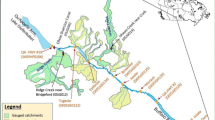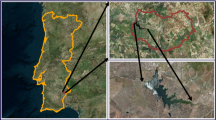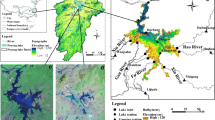Abstract
Lake Manzala remains the largest of the Nile Delta lakes and has undergone substantial recent changes particularly over the last 30 years due to regulation of freshwater inflows, land reclamation and increasing loads of BOD and nutrients. The latter are particularly associated with polluted drains flowing into the lake. An increasing fraction of the N load may also come from the expanding fish farming industry within and around the lake. Over the past 20–25 years, the N load from the drains has increased three times whilst the P load has remained approximately constant. This is despite a 40% reduction in freshwater inflows due to diversion of water towards the Sinai for land development. As a result of these changes, the concentration of total N in the drains has increased 4.5 times while the total P concentration has increased by 50% over the same period. Increases in nutrient concentrations can be attributed to increase in the use of fertilizer combined with an expanding population served by sewers, improved living standards and increased industrial production. Nutrient enrichment has resulted in declining water quality and eutrophication, especially in the southern parts of Lake Manzala. A combined hydrodynamic-ecological model has been set up for the lake and is used to analyse the development of water quality as a function of the load of organic material and nutrients. Model results show that 86% of the N load and 59% of the P load are retained within the lake. Despite the efficient treatment of wastewater by the lake ecosystem, approximately 6,000 tonnes of N and 1,300 tonnes of P are exported to the Mediterranean through the two main lake–sea connections. This nutrient export has important implications for coastal fisheries production. The present investigation suggests that the current anthropogenic nutrient load to the coastal zone exceeds that of pre-Aswan High Dam conditions despite large reductions in the annual pulse of water and nutrients brought about by the dam. A series of model simulations with reduced nutrient load are investigated in order to identify the conditions required to enable the propagation of vegetation throughout the lake. Submerged rooted vegetation is used as an indicator for water quality as it needs light for growth and in polluted, eutrophicated waters turbidity increases hampering vegetation growth. Simulation results indicate that the nutrient load has to be reduced to approximately 25% of the present loads if submerged rooted vegetation is to become re-established in the more polluted south eastern parts of the lake.
















Similar content being viewed by others
References
Ahmed, M. H., B. M. El Leithy, J. R. Thompson, R. J. Flower, M. Ramdani, F. Ayache & S. M. Hassan, 2009. Application of remote sensing to site characterisation and environmental change analysis of North African coastal lagoons. Hydrobiologia. doi:10.1007/s10750-008-9682-8.
Allan, T., 2000. The Middle East Water Question—hydropolitics and the global economy. Taurus Academic Publishers, London.
Ayache, F., J. R. Thompson, R. J. Flower, A. Boujarra, F. Rouatbi & H. Makina, 2009. Environmental characteristics, landscape history and pressures on three coastal lagoons in the Southern Mediterranean Region: Merja Zerga (Morocco), Ghar El Melh (Tunisia) and Lake Manzala (Egypt). Hydrobiologia. doi:10.1007/s10750-008-9676-6.
Benblidia, M., J. Margat & D. Vallée, 1997. Water in the Mediterranean Region: situations, perspectives and strategies for sustainable water resources management. Blue Plan for the Mediterranean, 2nd Ed. Regional Activity Centre (BP/RAC), Sophia Antipolis.
Biswas, A. K., 1993. Land resources for sustainable agricultural development in Egypt. Ambio 22: 556–560.
Bush, R. & A. Sabri, 2000. Mining for fish: privatization of the “commons” along Egypt’s northern Coastline. Middle East Report 216: 20–23 & 45.
DHI, 2007a. MIKE21 & MIKE 3 Flow Model, Hydrodynamic and Transport Module, Scientific Documentation. DHI Water Environment Health, Hørsholm.
DHI, 2007b. MIKE21 & MIKE 3 Flow Model, CSC Schemes, Scientific Documentation. DHI Water Environment Health, Hørsholm.
DHI, 2007c. ECO Lab, Short Scientific Description. DHI Water Environment Health, Hørsholm.
DHI, 2007d. Eutrophication Model 1 Including Sediment and Benthic Vegetation. DHI Water Environment Health, Hørsholm.
DHI, 2007e. Mud Transport Scientific Documentation. DHI Water Environment Health, Hørsholm.
Diab, A. S., A. Z. El-Nagdy, A. E. El-Regaal, I. M. Shaker, S. Fahmi, M. Hassan, R. M. Anwar, G. El-Azazy, M. E. El-Atta & A.M. Ezzat, 2007. The European Union’s Short and Medium-term Priority Environmental Action Programme (SMAP): Plan of Action for an Integrated Coastal Zone Management in the Area of Port Said (Egypt), Action 7: The execution of specific assessments in the coastal areas of Port Said: Fishery. Contract no. MED/2005/112–172. Final Report. EuropeAid Co-Operation Office, Cairo.
El Banna, M. M. & O. E. Frihy, 2008. Natural and anthropogenic influences in the northeastern coast of the Nile Delta, Egypt. Environmental Geology. doi:10.1007/s00254-008-1434-6.
Essa, M. A., A. M. Helal, M. A. A. El-Wafa & M. M. El-Gharabawy, 2005. Preliminary investigations into the inshore marine cage culture in Egypt and their impacts on marine resources. Egyptian Journal of Aquatic Research 31 (Special Issue): 309–320.
Ezzat, M. N., H. Shehab, A. A. Hassan, M. El-Sharkawy, A. El-Diasty, I. El-Assiouty, F. El-Gohary & A. Tczap, 2002. APRP-Water Policy Activity: Survey of Nile System Pollution Sources, Report No. 64. USAID/Egypt, Cairo.
Finlayson, M., G. E. Hollis & T. Davis, 1992. Managing Mediterranean Wetlands and their Birds. IWRB Special Publication, No. 20, International Waterfowl and Wetlands Research Bureau, Slimbridge.
Flower, R. J., 2001. Change, stress, sustainability and aquatic ecosystem resilience in North African wetland lakes during the 20th century: an introduction to integrated biodiversity studies within the CASSARINA Project. Aquatic Ecology 35: 261–280.
Flower, R. J. & J. R. Thompson (eds), 2006. MELMARINA: Monitoring and Modelling Coastal Lagoons: Making Management Tools for Aquatic Resources in North Africa: Final Report. IC-CT-2002-10009. Environmental Change Research Centre & Wetland Research Unit Department of Geography, UCL, London.
Flower, R. J. & J. R. Thompson, 2009. An overview of integrated hydro-ecological studies in the MELMARINA Project: monitoring and modelling coastal lagoons—making management tools for aquatic resources in North Africa. Hydrobiologia. doi:10.1007/s10750-008-9674-8.
Flower, R. J., P. G. Appleby, J. R. Thompson, M. H. Ahmed, M. Ramdani, L. Chouba, N. Rose, R. Rochester, F. Ayache, M. M. Kraiem, N. Elkhiati, S. El Kafrawy, H. Yang & E. K. Rasmussen, 2009. Sediment distribution and accumulation in lagoons of the Southern Mediterranean region (the MELMARINA Project) with special reference to environmental change and aquatic ecosystems. Hydrobiologia. doi:10.1007/s10750-008-9677-5.
Government of Egypt/WordFish Center Workshop, 2005. Strengthening Egyptian Fish Production: International Perspectives, Final Report (19 June 2005). Abbassa, Egypt.
Hollis, G. E., 1992. Implications of climatic changes in the Mediterranean basin: Garaet El Ichkeul and Lac de Bizerte, Tunisia. In Jeftic, L., J. D. Milliman & G. Sestine (eds), Climatic Change and the Mediterranean. Edward Arnold, London: 603–665.
Hughes, J. M. R., F. Ayache, G. E. Hollis, F. Maamouri, C. Avis, C. Giansante & J. R. Thompson, 1997. A Preliminary Inventory of Tunisian Wetlands. Report to EEC (DG XII), Ramsar Bureau and U.S. Fish and Wildlife Service. University College London, London.
Jeppesen, E., M. Sondergaard, M. Sondergaard & K. Christoffersen (eds), 1997. The Structuring Role of Submerged Macrophytes in Lakes. Ecological Studies 131. Spinger-Verlag, New York.
Kheder, A.-H. A., 1997. Aquatic macrophyte distribution in Lake Manzala, Egypt. International Journal of Salt Lake Research 5: 221–239.
Lazur, A. M. & F. Leteux, 2004. Integrated aquaculture systems for nutrient reduction in agricultural wastewater: potential and challenges. Japanese Bulletin Fisheries Resource Agency Suppl. 1: 143–151.
Little, D. & K. Satapornvanit, 1995. Poultry and fish production – a framework for their integration in Asia. Paper from the Second FAO Electronic Conference on Tropical Feeds, 9 September 1996–28 February 1997 (http://www.fao.org/ag/aga/agap/FRG/TFCONF2.HTM).
Luczak, C., M. A. Janquin & A. Kupka, 1997. Simple standard procedure for the routine determination of organic matter in marine sediment. Hydrobiologia 345: 87–94.
MacLaren Engineers Planners and Scientists Inc., 1981. Lake Manzala Study. Draft Final Report to the Arab Republic of Egypt and the United Nations Development Program. EGY/76/001–07, 12 Volumes. Ministry of Development and New Communities, Cairo.
MegaPesca, 2001. Marine Aquaculture in Egypt. MegaPesca, Alfeizeräo.
Nixon, S. W., 2003. Replacing the Nile: are anthropogenic nutrients providing the fertility once brought to the Mediterranean by a great river? Ambio 32: 30–39.
Oczkowski, A. & S. Nixon, 2008. Increasing nutrient concentrations and the rise and fall of a coastal fishery; a review of data from the Nile Delta, Egypt. Estuarine, Coastal and Shelf Science 77: 309–319.
Özhan, E. (ed.), 2005. Proceedings of the Seventh Conference on the Mediterranean Coastal Environment. MEDCOAST 05, October 25–29, Kusadasi Turkey. Medcoast, Middle East Technical University Ankara.
Perez-Ruzafa, A., C. M. Diego & J. Gilabert, 2005. The ecology of the Mar Menor coastal lagoon: a fast-changing ecosystem under human pressure. In Gönenc, I. E. & J. P. Wolfin (eds), Coastal Lagoons. CRC Press, Boca Racon: 392–421.
Ramadan, A. A., 2002. Population dynamics and multivariate analysis of vegetation in Lake Manzala, Egypt. Pakistan Journal of Biological Science 5: 842–852.
Ramdani, M., R. J. Flower, N. Elkhiati, M. M. Kraïem, A. A. Fathi, H. H. Birks & S. T. Patrick, 2001. North African wetland lakes: characterization of nine sites included in the Cassarina Project. Aquatic Ecology 35: 281–301.
Ramdani, M., N. Elkhiati, R. J. Flower, J. R. Thompson, L. Chouba, M. M. Kraiem, F. Ayache & M. H. Ahmed, 2009. Environmental influences on the qualitative and quantitative composition of phytoplankton and zooplankton in North African coastal lagoons. Hydrobiologia. doi:10.1007/s10750-008-9678-4.
Randazzo, G., D. J. Stanley, S. I. Di Geronimo & C. Amore, 1998. Human-induced sedimentological changes in Manzala Lagoon, Nile Delta, Egypt. Environmental Geology 36: 235–258.
Rasmussen, E. K., I. S. Hansen, A. C. Erichsen, D. Muhlenstein & J. Dørge, 2000. 3 D model system for hydrodynamics, eutrophication and nutrient transport. In Rodriguez, G., M. E. Perez & C. A. Brebbia (eds), Environmental Coastal Regions III. WIT Press, Southampton: 291–300.
Sadek, S., M. F. Osman & M. A. Mansour, 2004. Growth survival and feed conversion rates of des beam (Sparus aurata) culture in earthen brackish water ponds fed different feed types. Aquaculture International 12: 409–421.
San Diego-McGlone, M. L., S. V. Smith & V. F. Nicolas, 2000. Stoichiometric interpretations of C:N:P ratios in organic waste materials. Marine Pollution Bulletin 40: 325–330.
Shaheen, A. H. & S. F. Yosef, 1979. The effect of the cessation of Nile flood on the fishery of Lake Manzala, Egypt. Archiv fur Hydrobiologie 85: 166–191.
Shakweer, L., 2005. Ecological and fisheries development of Lake Manzalah (Egypt). 1. Hydrography and chemistry of Lake Manzalah. Egyptian Journal of Aquatic Research 31: 251–269.
Shehadeh, Z. H. & I. Feidi, 1996. Aquaculture development and resources limitations in Egypt. FAO Aquaculture Newsletter December 1996 No. 14, FAO, Rome.
Smart, M., 2002. Wetland conservation and restoration in the Maghreb. In Zalidis, G. C., T. L. Crissman & P. A. Gerakis (eds), Restoration of Mediterranean Wetlands. Hellenic Ministry of the Environment, Physical Planning and Public Works, Athens, Greece and Greek Biotope/Wetland Centre. Thermi: 165–178.
Stanley, D. J. & A. G. Warne, 1993. Nile Delta: recent geological evolution and human impact. Science 260: 628–634.
Sultan, M., M. Fiske, T. Stein, M. Gamal, H. El Aradby, A. Madani, S. Mehanee & R. Becker, 1999. Monitoring the urbanization of the Nile Delta, Egypt. Ambio 28: 628–631.
Taha, A. A., A. S. El-Mahoudi & I. M. El-Haddad, 2004. Pollution sources and related environmental impacts in the new communities southeast Nile Delta, Egypt. Emirates Journal for Engineering Research 9: 35–49.
Tennessee Valley Authority, 1997. Project Document: Lake Manzala Engineered Wetland. Tennessee Valley Authority, Knoxville, USA Prepared for United Nations Development Programme, New York.
Thompson, J. R., R. J. Flower, M. Ramdani, F. Ayache, M. H. Ahmed, E. K. Rasmussen & O. S. Petersen, 2009. Hydrological characteristics of three North African coastal lagoons: insights from the MELMARINA project. Hydrobiologia. doi:10.1007/s10750-008-9680-x.
Toews, D. R., 1986. Fishery transformation on Lake Manzala, Egypt, during the period 1920 to 1980. In Schmidthe, N. W. (eds), Toxic Contamination in Large Lakes. Vol. 2. Impact of Toxic Contaminants of Fisheries Management. Proceedings of a Technical Session of the World Conference on Large Lakes, 18–21 May 1986, Mackinac Island, Michigan: 25–50.
Toews, D. R. & M. M. Isak, 1984. Fishery transformation on Lake Manzala, a brackish Egyptian Delta Lake in response to anthropological and environmental factors during the period 1920–80. General Fisheries Council for the Mediterranean Studies and Review 61: 347–402.
Zalat, A. & S. S. Vildary, 2005. Distribution of diatom assemblages and their relationship to environmental variables in the surface sediments of three northern Egyptian lakes. Journal of Paleolimnology 34: 159–174.
Zalat, A. & S. S. Vildary, 2007. Environmental change in Northern Egyptian Delta lakes during the late Holocene, based on diatom analysis. Journal of Paleolimnology 37: 273–299.
Acknowledgements
The MELMARINA Project was financed by the EU Framework V INCO-Med Programme (Grant ICA3-CT2002-10009). The authors acknowledge the assistance of all the partner institutions in the project. Particular thanks are extended to those who participated in the field programme at Lake Manzala.
Author information
Authors and Affiliations
Corresponding author
Additional information
Guest editors: J. R. Thompson & R. J. Flower
Hydro-ecological Monitoring and Modelling of North African Coastal Lagoons
Rights and permissions
About this article
Cite this article
Kock Rasmussen, E., Svenstrup Petersen, O., Thompson, J.R. et al. Hydrodynamic-ecological model analyses of the water quality of Lake Manzala (Nile Delta, Northern Egypt). Hydrobiologia 622, 195–220 (2009). https://doi.org/10.1007/s10750-008-9683-7
Published:
Issue Date:
DOI: https://doi.org/10.1007/s10750-008-9683-7




